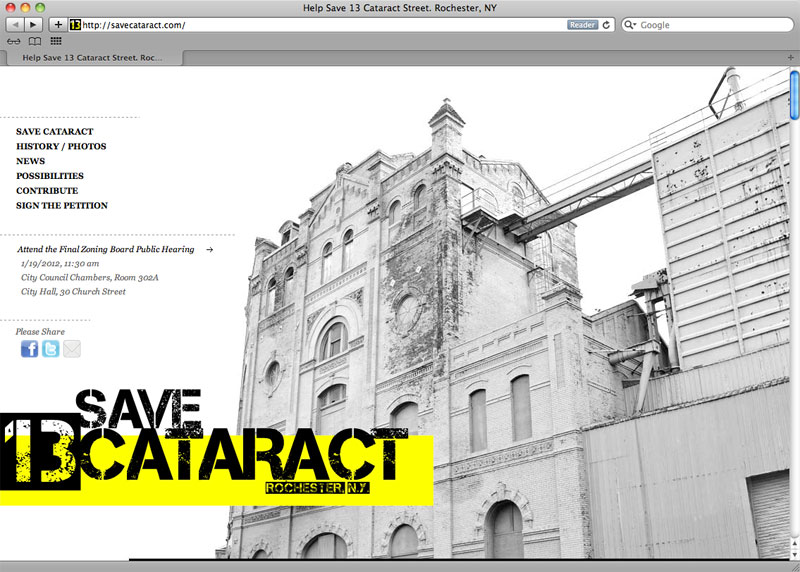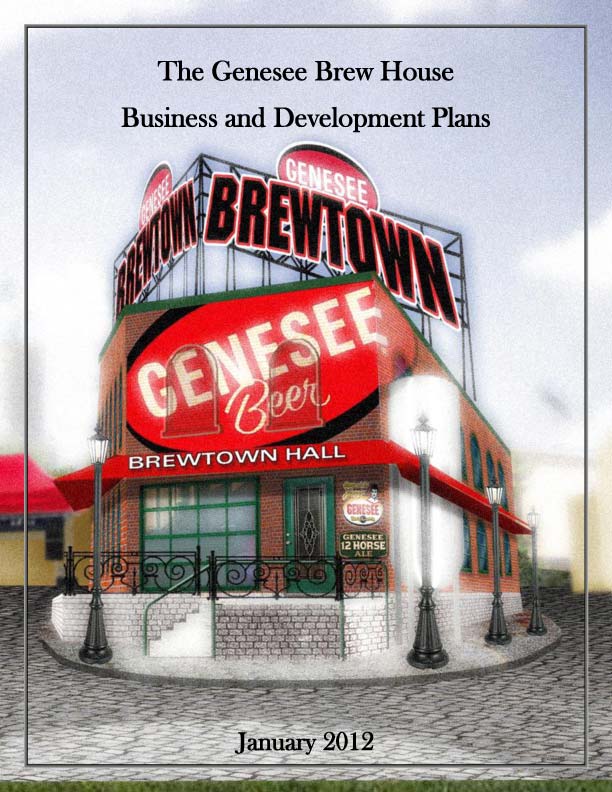This article was scraped from Rochester Subway. This is a blog about Rochester history and urbanism has not been published since 2017. The current owners are now publishing link spam which made me want to preserve this history.. The original article was published January 10, 2012 and can be found here.

A new web site, SaveCataract.com

, and a mountain of information on Rochester's endangered Cataract Brewery building has surfaced this week... The accomplished life (and death) of its architect... Original architectural drawings... And new documents submitted by North American Breweries to the Zoning Board (see the section called Offers to Buy Cataract ). Ready? Let's dive right in...
The Father of Cataract
![An ad for New England Brewing Co. (1907, Geers Directory). That's an image of A.C. Wagner, architect of our 13 Cataract building. [IMAGE THANKS TO: Joel Helfrich, Adjunct Assist. Prof. of History, MCC]](https://senseofplace.dev/content/images/photos/ac-wagner-new-england-brewing-ad-1907.jpg)
Adam C. Wagner, often referred to as A. C. Wagner, was the architect and designer of more than 50 breweries during his lifetime. Most significantly for the Rochester community, we now know he designed for the Standard Brewing Company the impressive, still-standing brewery building on Cataract Street

. Eventually, the building would be named after one of only five Rochester breweries to survive Prohibition: the now defunct Cataract Brewing Company.
Wagner died, aged 74, on January 10, 1935, in Hartford, Connecticut, "after a short illness." He remains dead 77 years later--but not his legacy.
![13 Cataract Street was built for Standard Brewing Co. in 1889. It was designed by A.C. Wagner who supervised the construction of over 50 brewery complexes across the country in the late 1800's and early 1900's. This is one of Wagner's original drawings of 13 Cataract Street. [IMAGE THANKS TO: Rich Wagner, pabreweryhistorians.tripod.com]](https://senseofplace.dev/content/images/photos/ac-wagner-standard-brewing-building-med.jpg)
His death should give all Rochesterians pause to consider not only their own mortality but also Wagner's significant impact on the history of late nineteenth and early twentieth century brewery architecture and brewing history. Moreover, we should ponder the potential loss of one of the few remaining examples of Wagner's architectural skill. Indeed, breweries were Wagner's "specialty," according to The Athenaeum of Philadelphia [PDF] , "and he worked for some of the largest brewing companies in and out of Philadelphia", including:

(Philadelphia)
- Anheuser-Busch (Philadelphia)
- Bavarian Brewing Company (Wilmington, DE)
- Steigmaier Brewery

(Wilkes-Barre, PA)
Of all of the breweries and structures that Wagner designed, only a few buildings remain:

(Philadelphia)

(Wilkes-Barre, PA)
- And of course, the Cataract Brewery

(Rochester, NY)
Cataract's Big "Sister"
![Wagner's New England Brewery building in Hartford, CT. looks remarkably similar to our Cataract Brewery here in Rochester. [ARTICLE: Hartford Courant, 10-30-1911]](https://senseofplace.dev/content/images/photos/new-england-brewerys-enlarged-plant.gif)
The breweries he designed in Hartford, New Haven, and elsewhere have been torn down. That's Wagner's New England Brewery building in Hartford, CT. (left). It looks remarkably similar to our Cataract Brewery here in Rochester.
From this article [PDF] , it sounds like our building may have been designed with the same purpose in mind--storage of malt and hops. Five stories and several cellars, cooled to the appropriate temperatures using a 70-ton refrigeration machine with condensers so large "three railroad cars" were needed to haul it to the building all the way from Frick Co.'s Works in Waynesboro, PA. These massive condensers were housed on the fifth story.
An Accomplished Life
Wagner was born in Saxony, Germany

, in February 1860. He came to the U.S. circa 1876, and married his first wife, Lena, with whom he had four children; all born in Philadelphia. Two of his daughters, Gladys and Katchen, survived into adulthood. Lena died on January 11, 1916. Wagner remarried by the 1920 census to a woman named Anna, who died in 1951.
Wagner and his family moved from Philadelphia by the turn of the twentieth century. According to the 1898-1899 edition of American Brewers' Review: A Monthly Devoted to the Science and Practice of Brewing (vol. 12), Wagner, "The Philadelphia brewery architect," was hired to construct a "new office building" for the brewery for Theresa F. H. Weibel of New Haven, Connecticut. In 1897, he and his family made their way to Hartford, Connecticut, where Wagner became involved with the New England Brewery. He was hired by the Hartford Brewing Company to design a six-story fireproof lager and ale brewery with a boiler and bottling house. The 1900 Census in Hartord and the 1901 City directory for Philadelphia cite Hartford as his residence.
![A.C. Wagner also designed this American Brewing Company building on Hudson Avenue between Merrimac and Wadsworth Streets. [IMAGE THANKS TO: Rich Wagner, pabreweryhistorians.tripod.com]](https://senseofplace.dev/content/images/photos/ac-wagner-american-brewing-building-med.jpg)
By the time he left Philadelphia he had designed more than 50 buildings, from Washington, D.C., to Rochester, New York, to cities throughout New England. Interestingly, Wagner designed the Kalmbach and Geisel Brewery (later known as the Highland Brewery and then Liberty Brewing Company, but referred to by locals as "Come Back and Guzzle"), the largest in New England before the passage of the Eighteenth Amendment to the Constitution: Prohibition, in place from 1920 to 1933. The father of the literary Dr. Seuss (Ted Geisel) was the co-owner of that brewery in Springfield, Massachusetts.
However, Wagner was more than just one of the most famous brewery designers. He had extensive training and knowledge as a cooper, brewer, engineer, chemist, contractor, and architect. He was also a successful businessman who was always willing to lend his offices for various social and patriotic causes, such as Jews relief in Israel and Palestine in 1922 or the sale of Liberty Bonds to support U.S. government involvement in World War I. He was the founder and president of a number of businesses, including the Merchants Ice Company and, in the years before his death, the Yale Brewing Company. He was involved in real estate and was "associated" with the New England Fruit Company.
In 1914, he astutely testified in a court case [PDF] defending the Breidt Brewing Company, another brewery that Wagner had designed and built, regarding its "beer vats that were the subject of the suit." His training and knowledge in many and various skilled professions was essential in the case. The "crack Metropolitan lawyer," who was "handy in confusing witnesses," made little headway when Wagner took the stand to testify.
The following obituary was printed in The Hartford Courant on January 11, 1935. Thanks goes to our friend Joel Helfrich for digging this up...
Adam C. Wagner, Builder of Many Breweries, Dead
Head of Yale Brewing Company Passes at Prospect Avenue Home Adam C. Wagner, president of the Yale Brewing Company since its organization in 1933 and builder of more than 50 well-known breweries in the United States, died Thursday morning at his home, 558 Prospect Avenue

, after a short illness. Born in Saxony, Germany, a son of the late Charles and Catherine Wagner, he came to the United States when he was about 16 years old and settled in Philadelphia. While living in Philadelphia, Mr. Wagner was in the building business and such breweries as the National Capitol Brewing Company

of Washington, D.C., the Philadelphia Brewing Company of Philadelphia

, the American Brewing Company at Rochester, N.Y., and others were constructed under his supervision. In 1897 Mr. Wagner became interested in the New England Brewery , of which he was former president and treasurer. When prohibition came, Mr. Wagner closed the plant and the business was dissolved. He then became associated with the New England Fruit Company. Mr. Wagner, who was also in the real estate business, developed the Manitok Lake section of Granby

. He leaves his wife, Mrs. Anna (Wall) Wagner; a daughter, Mrs. Katchen Wagner Meyer of Hartford; and a sister, Mrs. George Schmidt, in Germany. The funeral will be held Saturday at his home and will be private. Burial will be in Cedar Hill Cemetery.
Priceless Treasure, Not Disposable Junk
Wagner's architecture, the few examples that remain, should be stabilized, restored, preserved, and used by the public, especially since his buildings were meant to be used. The Cataract Brewery buildings in Rochester, should certainly be preserved. From their perch on the banks of the Genesee River, Rochesterians might one day be able to enjoy the best views of High Falls and see the history that Adam Wagner and other architects, noteworthy or otherwise, helped to create.
Offers to Buy Cataract
Now, if only North American Breweries had a buyer for Rochester's historic Cataract building, then they wouldn't have to tear it down. Such a shame.

Whoops, look what we just found... Not just one, but TWO offers to buy Cataract [PDF] . I guess these didn't count when North American Breweries said they received "no viable offers?!"
I don't know about you, but When demolition is estimated to cost $600-$800k, purchase offers of $275k and $100k sound pretty darn "viable" to me.
Maybe I'll give them the benefit of the doubt. Perhaps they honestly forgot to bring these documents to the first Zoning Board Meeting. But, if we're being honest, I would like to know a few things: What happened to these offers? Were they ignored, like the offer made by the GardenAerial group to take the building as a charitable contribution? Or, did Costanza Enterprises and John Thomas Property Management both have a change of heart after submitting their offers?
More importantly, did North American ever have any intention of finding a good owner for Cataract? I mean seriously, we've now learned of THREE offers to take ownership of 13 Cataract. Are there any others we don't know about yet?
North American Breweries, back a-way from the wrecking ball... please.


